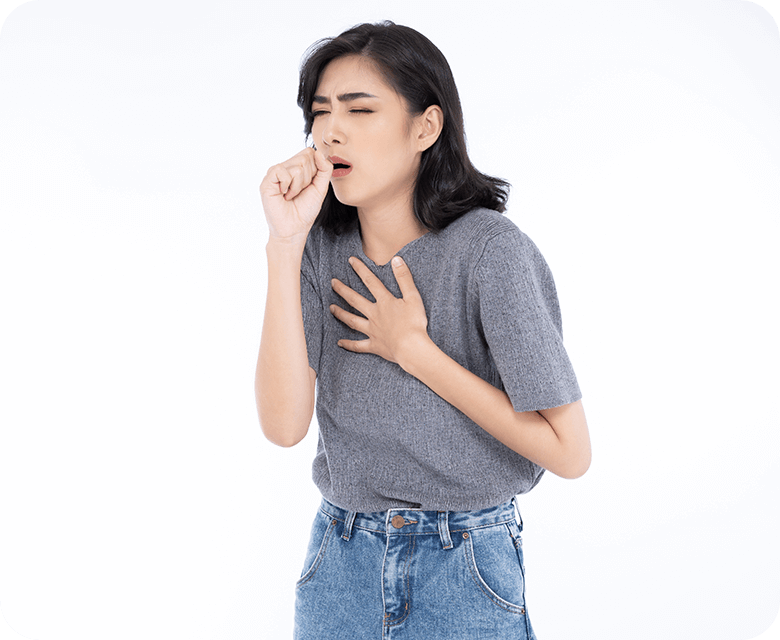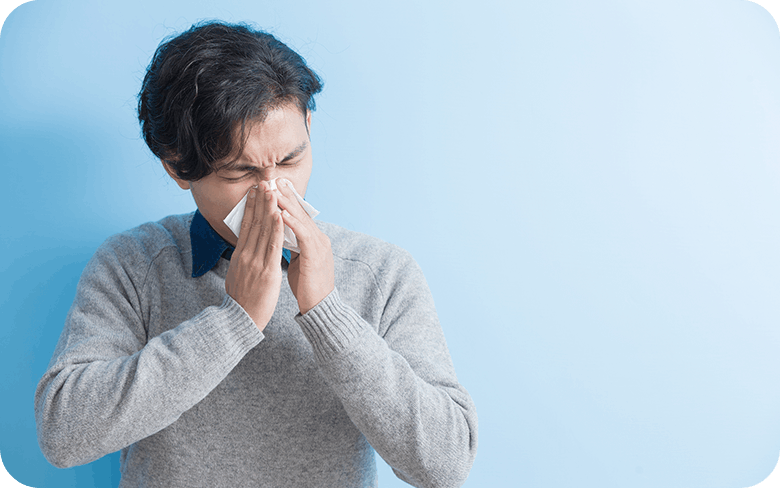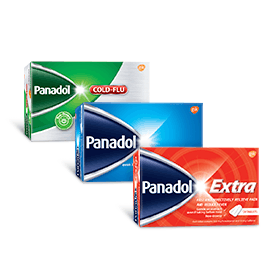Colds are common: Most adults get a cold at least once a year while children can get them multiple times in a year. The common cold is an upper respiratory viral infection caused by different viruses. Symptoms include a nasal congestion, cough, sore throat, runny nose, and fever—the common cold can leave you feeling miserable.

When do people catch colds and how long do they last?
Most people tend to get a cold during the winter months, but it can happen at any time during the year. A cold usually lasts up to 7 to 10 days. Although colds and flus may seem similar, they’re not the same. A flu usually causes more severe symptomsviii.
While there are no cures available for the common cold, medicine products containing paracetamol and bed rest can help speed up your recovery.
Is it a cold? The top three symptoms
After your exposure to a cold virus, symptoms usually come on within three to four days. A scratchy throat is often among the first signs that you’re coming down with something. Later, you could develop a cough and a runny nose. If you’re feeling run down or achy, it’s likely that you’re getting a cold. Signs tend to vary from person to person, but cold symptoms tend to include:
- A sore throat and/or cough
- A runny and a stuffy nose
- Body aches and a general sense of feeling unwelliv
What are the signs of the common cold?
Colds can make you feel tired and like you’re running out of steam. But with more than 200 different viruses that can cause cold, its symptoms tend to vary from one person to the next. Usually, a cold affects your whole bodyi.
The symptoms of a common cold include:
- A runny, blocked nose and congestion: A congested nose and thick nasal discharge are some of the tell-tale signs of the cold. A blocked nose feels uncomfortable and like you can’t breathe properlyviii. The mucus build-up could also lead to postnasal drip. In that case, you will notice the mucus travelling down from your nose to your throat. Because of congestion, your taste and smell may be different or be temporarily lost.
- Sneezing: When the mucous membranes in the nose and throat are being irritated, it can trigger sneezingii. Because sneezing spreads cold viruses, you should cover your nose with a tissue when you’re sneezing.
- Scratchy, itchy, sore throatviii: When the tissues that line the back of your throat are inflamed, it can become painful. A sore throat usually feels dry or itchy and as if something is stuck at the back of it. Some people may also find that it hurts when they swallow foods. Your voice could sound hoarse or raspy.
- Cough: Coughing usually starts as a tickle at the back of the throatviii. This is caused by an irritation or inflammation of the cells in your airways.
Coughs can be wet or dry. The difference is that a wet cough brings up some of the mucus from your respiratory system. Wet coughs feel like something is stuck in your throat and you will usually be able to feel that there’s mucus. As the name suggests, the dry cough is not accompanied by mucus build-up. It feels like a tickle or as if something is scratching against the back of your throat.
Coughs can linger and are sometimes the last symptoms of the common cold to go awayiii.
- Body aches and headaches: In addition to the above, most people will also feel body aches, neck pain, or mild headaches when they have a cold. You may notice a general feeling of being unwell or run down. Often people will feel more tired and fatigued as their immune system tries to fight the virus.
- Body chills and fever: A temperature above 100.4° F is rare in adults—but common among children—with coldsiv. Signs of a fever include sweating, chills and shivering, and dehydration. If you notice a higher than average temperature in your infant or child, you should consult a doctor.
What’s the difference between a cold and the flu?
We’ve all had a cold before, but sometimes it can be difficult to figure out whether your illness is a cold or the flu. So how do you know? Flu symptoms tend to be more severe and come on much quicker than those of a cold. One of the key difference between cold and flu is a fever, but there are a few other signs to look out forviii:
Symptom |
Common cold |
Flu |
Fever |
Not common in adults or mild; more common in |
Very common |
Headaches |
Sometimes |
Common |
Body aches |
Sometimes |
Common |
Fatigue |
Common |
Very common |
Stuffy and runny nose |
Very common |
Sometimes |
Sore throat |
Very common |
Sometimes |
Cough |
Common |
Common |

What exactly is a cold?
The common cold is a seasonal infection of the respiratory tract. It is caused by viruses called rhinovirus and spread from person to person via skin contact or in the air—for example, when an infected person sneezes.
Symptoms tend to come on within three to four days after exposure and last up to 7 to 10 days.
The U.S. Centers for Disease Control and Prevention estimate that the average adult has between two to three colds a year. Children tend to get ill even more oftenv.
- Immune system: If you suffer from a chronic illness or have a compromised immune system, you may suffer from colds more frequently than healthy people.
- Age: Children under the age of six years get colds more often than adults or older kids.
- Contact with other people: When you work in a busy environment, you tend to come in contact with other people more frequently. This means that the virus spreads more quickly.
- Stress: When you’re stressed, your immune system functions are suppressed and this can make you more susceptible to the commonvi cold.

How can I treat a cold quickly?
Colds can be debilitating. They’re one of the main reasons why adults miss work and children have to stay home from schoolv.
It’s only normal that you may be looking for cold remedies that provide quick relief. But there is no cure for the common cold or flu.
In general, a cold requires bed rest and time for the cold to run its course and the body to heal. Available cold medicine and other treatment options focus on relieving symptoms.
What cold medicines can I take?
- Pain and fever relievers: If you’ve got a fever, sore throat or headache, you can take pain medication like Panadol for colds which contains paracetamol. Studies have shown that paracetamol and other painkillers can relieve the pain associated with colds and flusvii.
They also help lower a fever. Standard formulations of painkillers do not help with a stuffy nose or congestion. Panadol Cold & Flu includes phenylephrine hydrochloride to relieve stuffiness and dextromethorphan to suppress that nasty, dry cough.
- Nose sprays: Decongestant nasal sprays are helpful to relieve symptoms of a runny or congested nose. But they shouldn’t be used for more than 7 daysvii.
- Cough syrup: It can be difficult to get rest when a cough keeps you awake. Cough syrups help to suppress a cough and allow you to get much needed sleep.
- Children Consult your doctor before giving cold medicines to children younger than four years. If your little one has a fever, it’s best to use suppositories like those from Panadol because they’re easier to give than oral tablets or drops.
You should not use antibiotics to treat a cold unless its a bacterial infection. Speak to your doctor if you’re in doubt.
What home remedies help?
- Sleep: It’s important that you rest when your body is trying to fight a cold. If you can, stay home and get plenty of sleep.
- Drink lots of fluids: Make sure you get plenty of water. To sooth a sore throat, you can try some hot lemon with honey or herbal teas. Soup is a good choice for food because it rehydrates and soothes a sore throat.
- Vitamins: Although there is no proof that vitamin C or zinc help treat a common cold, they can be beneficial for general health and boost your immune system in the long runix.
When should I call a doctor?
Speak to a doctor or medical advisor if you have any of the following as these could be signs of other infectionsx:
- A fever that doesn’t go away: If your fever lasts more than three days, it could point to a bacterial infection that may need alternative treatmentx.
- A cough that lingers: When a cough continues for more than two to three weeks or is particularly bad, it’s best to speak to a medical advisor as it could be a sign of bronchitisxii
- A painful throat: Although a sore throat is common when you have a cold or flu, severe pain is also a symptom of strep throatx
- Face pain, congestion and yellow or green nasal discharge: If you notice any pain around your nose, the forehead or in the cheekbones, you may have sinusitis. Congestion and yellow or green mucus can be signs of inflamed sinuses. Because sinusitis is sometimes caused by bacteria, it will require a different treatmentxi.









